Why ease of use doesn’t happen
In honor of world usability day, here’s an essay that examines the causes of bad designs, and offers advice on avoiding them.
In honor of world usability day, here’s an essay that examines the causes of bad designs, and offers advice on avoiding them.
Still seeing some reviews come in which I’m grateful for, 5 months after the book has been out. Most folks don’t know it but the window for books is small: if it’s not picked up in reviews soon after publication, odds are slim anyone will ever even hear about it.
My own interests aside, any time you write a blog post or amazon review for a book, it makes a huge difference to us authors. Even if sales don’t follow, it’s super validating to any author to hear the book meant something to someone. I hope to write more book reviews myself here.
MSDN Magazine had a short review of artofpm:
Scott gives you project management concepts in simple steps, using lots of examples of successes and failures from his own experiences, and he is always considering the “people” factor. With all the emphasis on tools and process that we have today, it’s refreshing to see a book on project management that spends as much time on human factors as it does on technical tools and metrics.
This book is a candid and honest piece of work written by someone who has really been there, done that, and is willing to share.
Boxes and arrows, a webzine about information architecture and UX, had this review:
This is a comprehensive, how-to book devoid of jargon and theory. The author gives direct advice from his own experience. The real value of this book, though, is that it is not about a single methodology for project management, nor is it just for project managers. Instead, Berkun is able to speak about project management at its highest-level without filtering it through a given approach. It is deep enough to keep seasoned project managers reading, but also appealing to non-project managers. I’d recommend this book to anyone looking to improve general project skills.

Tommorow is the first annual world usability day. Free events all over the world are taking place to promote ease of use and good design in everything.
I’m surprised not to see more events in the SF Bay area or Seattle (Nothing at Microsoft, Amazon.com, Zaaz, Blink, Real, Saltmine, Adobe ?) so I’ll do my part:
I’ll do 100% free expert reviews of the first 3 websites people submit in comments (I will likely do many more but I can only promise 3). It can be your website, your company’s, a site you use or something you think would be interesting (or entertaining) to have me critique.
Update: About ten in already but do keep them coming. I will do as many of these as I can tommorow and more over the next week. It’s not too late.
Whenever data is misused as the only means for making decisions, a death spiral begins. Blind faith in data creates a false confidence that overwhelms reason. Decision makers forget their wisdom and wait for numbers, fueling an addiction to unnecessary, biased and distracting data. Cowardly decision makers thrive in unnecessary information, their fears can hide there, and the data can be used to the wise with blankets of endless numbers and facts of dubious value.
Data can be good: it can dispels ignorance and raises questions. But data doesn’t make decisions or find good ideas: people do. As soon as you discount people in the name of data, the downward spiral begins.
You know you’re in a data death spiral if:
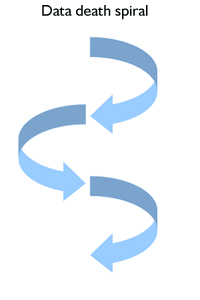
How death spirals start
The spiral begins with ignorance. Leaders confuse the collection of research with thought. People who throw more data (not better) at problems are rewarded and others follow. Soon no idea can be suggested without a data armory. Meetings are data battlegrounds. Or worse, data massacres. When someone says “Morale is low. People are crying in the halls. We must do something.” another says “but where is your data?” and the conversation ends.
As the spiral bottoms out, people are proud of numbers and slide decks: not the results.
Steps to preventing death spirals
See also:
Judging by the low number of comments, my book tour travelog has been a snorefest so I’ll wrap up the remains in one post.
Friday 10/14: I dropped in at Razorfish and Google NYC and talked about user centered design, leading development teams and the challenges of making good things. One of the folks at Razorfish, Vincent Santo, was an Interactionary survivor and we chatted about that. Karen McGrane, my excellent host, was great and as cool as I expected. Over at Google I was hosted by Leslie Yeh, who worked on my team for awhile back at Microsoft. Their office near Broadway was slick: 3 stories cut away into a central opening, with enough room for two basketball hoops. My kind of office.
Monday 10/17: As a kid I walked by the Cooper Union campus dreaming about going there one day. Well the day came: I got to speak to 120 students and faculty about lessons I learned at Microsoft. It turned out much of the crowd were freshmen, so I quickly ditched most of my slides and let them ask me questions for an hour. It was a thrill and an honor: after a few jabs at MSFT the focus turned to business, innovation and the differences between being a student and a professional. Best question asked: Who would win in a fight, Bill Gates or Steve Jobs?
Tuesday 10/18: The full circle was complete: I spoke at CMU where I graduated in ’94. Catherine Copetas was my fantastic host with CS department and set up two talks: a small informal talk and a big lecture. The lecture was in Wean 7500: A room I had fallen asleep in countless times as a student. Speaking in that huge cavern of a room was a right of passage. Bonnie John, the director of the masters program at the CMU HCI institute, and a former professor of mine was there and we chatted afterwards. It’s fantastic to see that what was a collection of courses when I left, has blossomed into an entire HCI group: they’re setting an example for other CS departments to follow.
Wednesday 10/19. Had I planned better, I’d have used this day to see more friends in Pittsburgh. But I was exhausted and mostly slept late at Faisal‘s and then crawled out to Shadyside and wrote in a coffeeshop on Walnut Street. I ate a late breakfast at the legendary Pamelas, bought a sandwhich to bring home to my wife at the Peruvian place (La Feria), and spent a ton of cash on cool CDs at the world music store. Walnut street still has a special quiet hip charm hard to find in most cities.
Thursday 10/20: Homeward bound. By 4pm I was back in the woods and sleeping comfortably, with my dog Max, on the couch. 12 days, 3 cities, 9 talks, lots of cool new people and old friends, but time for sweet dreams.
If you want lesssons learned from this, my 2nd book tour, comment away. Otherwise I’ll leave the tour behind.
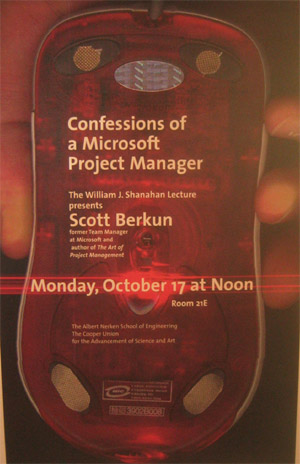
This week in the pm-clinic discussion forum: Topic #51 – Making handoffs.
Here’s this week’s situation:
I’m a lead programmer at a software development shop. My problem is handoffs: my group stinks at them. We have business folks that write requirements docs, but the way they hand them off to my team is a joke. They don’t involve us in the process and don’t help us resolve ambiguities in what they created. Then there are poor handoffs to test, and again to marketing. It seems almost every handoff is done poorly: it’s almost expected.
How can/does a team learn to make better handoffs with work that cuts across jobs/roles?
– Death by fumbling
Short notice, but if you’re an amazonian working in Seattle, I’ll be speaking at the Friday speaker series today at noon on “Why smart people defend ideas“. Hope to see you there.
I’m promised a copy of the video of the talk and I’ll make it available online if possible.
Thanks to Jordan Rule and Werner Vogels for making this happen.
Thursday was my first day off: a travel day. A short cab ride and I was in Boston’s historic south station. To my delight, they even had a bookstore in the center of the main concourse.
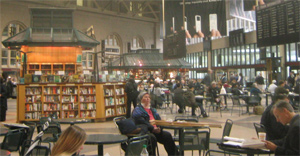
The train is a better experience than air travel, hands down. The stations are often beautiful old buildings with dramatic large spaces and high ceilings. Getting on and off doesn’t require snaking security lines and obsessive ID and boarding pass checks. Wandering around South station I kept looking up, entertained by the sheer size of the waiting area. They just don’t build buildings like that anymore. Unlike airports, you get a sense that you’re really somewhere, even while you’re waiting to go somewhere else.

On the trains themselves there’s more room, power access and a dining car (the food ain’t great, but you’re choices are better than airplane’s standard chicken or pasta). And unlike air-travel where there’s a rush hour panic vibe and people’s smelly elbows in your face, the train is downright civilized. Plenty of space. Wide seats. Quiet cars. I suspect the 8am train would have been crazier than my 11:15, but I had a most enjoyable ride.
Perhaps I have train envy. In Seattle, where I live, it doesn’t seem we’ll ever have train service of any kind. The history of mass transit here is a tragic tale than spans decades and is simply too sad to get into here. It’s a classic tale of bad project management.
3 hours later I arrived at Penn Station and had my ritualistic thrill of walking up to the chaos of the midtown NYC streets. That energy rush always gets a rise out of me: it’s the lovable insanity of home.
One of the things stupid people do is this: Person A (aka Mr. stupid) writes a requirements document. He makes it super detailed and 50 pages long. He then throws it blindly over a wall (thud!) to person B and says “Do this.”
This is evil and dumb for the following reasons:
Every time I hear about organizations that draft requirements in private, I choke. It’s a sure sign that creative thinking of any kind is seen as disruptive rather than constructive.
Requirements should be built in the open, with invitations to designers of all kinds to vet out requirements early on with rough prototypes and mock-ups to prove (or disprove) the assumptions made by the requirements. If quality requirements are the goal, there is every motivation to involve the people who will do the work in the their definition.
You want overlap of involvement in the production of any requirement (or document) between the creators and the users, as in this diagram. Ideas show flow freely between them. It should be a dance of analysis (business dude) and synthesis (designers/engineers).
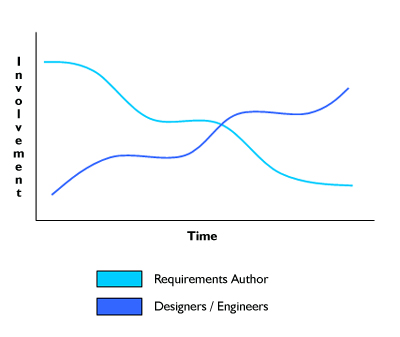
You can replace the legend with any pairing of creators and consumers within a team and it still works. Programmers/Testers, Product managers/Program Managers, Designers/Engineers, etc.
You could argue that the lines should run in parallel for longer, with two or more people working as peers in the process until there is enough stability for a handoff. My point with the squiggly lines is that it fluctuates, but that it’s always clear who the primary driver is.
But the core of my point is overlap of involvement. Regardless of method (agile, waterfall, VP whim, utter chaos) you want to collaborate over important decisions, exploring alternatives and using cross-disciplinary perspective to draw the best thinking to the surface. There’s never a reason not to.
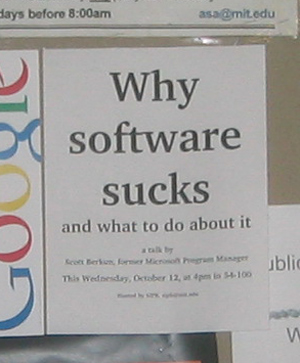 I quickly lost myself in the MIT campus. It was fun to poke my nose into classrooms and departments observing everyone busily doing their things. I must have fit right in, as two different people asked me for directions.
I quickly lost myself in the MIT campus. It was fun to poke my nose into classrooms and departments observing everyone busily doing their things. I must have fit right in, as two different people asked me for directions.
The talk, Why software sucks, was nearly canceled. Someone was upset about the title and it was cancelled from the seminar series. I called (ok begged) the fine folks at the student run SIPB and they came through, rescheduling the talk and hosting me on campus. Kudos to Jeff Arnold and Jennifer Tu. They had posters up all over the place (see photo above) and spread the word.
There were about 100 people in the 54-100 lecture hall (see photo). Despite the size I had lots of good questions and a good two dozen people stuck around for a long Q&A session. I was impressed with how many questions there were about process and engineering. Someone asked about why certain bugs in Word (or other v 12 software) will never be fixed: and we talked about the challenges of platforms.. how the risks for certain bits of code can become higher than the return value in making changes (a reverse econony of scale for software). Somewhere in there is a business/engineeing case study waiting to happen.
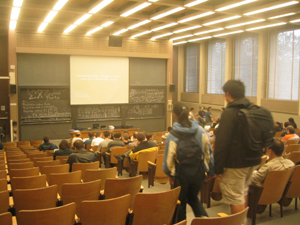
You always want the best people, but sometimes the best people don’t fit together into a harmonious team. How do you manage star egos? How do you build good teams, with or without stars? I answer these questions and more.
This week in the pm-clinic discussion forum: Topic #50 – How to be the Wolf.
Here’s this week’s situation:
Imagine that you are made a job offer where you need to “whip into shape” the organization. You’ve been briefed on some of the issues they’ve been facing and are brought in to turn the team around. What kind of questions should you ask before taking such a job? What resources would you ask for? What authority would you need? How much information does a candidate need before accepting such a task?
– How to be the Wolf
fyi: The Wolf is a character from the film Pulp Fiction that comes in to save the day. . Also related to “The cleaner” from La Feme Nikita.
Lifehacker has a good essay on decision making. It neatly sumarizes 3 or 4 of the basic and handy ways to make tough calls.
I’m more fond of pro con lists than anything else. They’re quick, dirty, and easy to share. Expected value requires to much math invention for my tastes unless I’m working with money or the pure P&L (profit and loss) figures.
Robbie Allen has a great writeup from the Harvard University Startup school that took place last week. Speakers included people from O’Reilly, Apple (Wozniak), Yahoo, Google, Y combinator (Graham), Tripadvisor, Bloglines, Feedburner, etc.
When I was a student at CMU, I thought of MIT as the school we wanted to compete with but who didn’t know who we were. It was kind of like picking a fight with someone twice your size: it’s not that you’d lose, it’s that they didn’t even care. So visiting MIT was a thrill: I’d read so much about the place, and the legendary hacks, that I had fun just walking around on campus. (It’d make an interesting contrast a few days later when I spoke at CMU).
 I walked the 15 minutes from the ever swanky hotel Marlowe and met Daniel Jackson from the CS department. The Strata center, where his office is, is a wild Ghery designed skyline of buildings and it was a trippy thing to see early in the day. Jackson and I chatted about teaching programming and organizing teams, but soon I had to run off to talk at the Sloan school.
I walked the 15 minutes from the ever swanky hotel Marlowe and met Daniel Jackson from the CS department. The Strata center, where his office is, is a wild Ghery designed skyline of buildings and it was a trippy thing to see early in the day. Jackson and I chatted about teaching programming and organizing teams, but soon I had to run off to talk at the Sloan school.
I had no idea what to expect: I’m entirely depedent on my host at each of these gigs to promote or advertise the talk, and for this one I expected to 8 or10 people and a small room, for an informal chat. Well, I was wrong. Yuntao Edward Shi (of the mediatech club), my host, filled the medium size room with nearly 100 MBA students. I was late to the building and scrambled to find the room, and had a sureal moment of “that room is really crowded it can’t be it. Wait. That’s it.”
Sticking with my plan I kept the talk informal. After a brief intro I asked the crowd what they wanted to talk about and let them veto entire sections from my slides. It was great. Someone asked about anti-trust, another about managing people smarter than you and the session just flew by. These guys are smart: looking forward to seeing what they do after they leave Sloan.
At 12:59pm we were kicked out by some TAs setting up for an exam. I had flashblacks to scrawling long missives in those little blue books they make you write in. I smiled inside, being so happy to never ever have to take an exam again.
The next talk at MIT wasn’t until 4:30pm. Robbie Allen, esteemed O’Reilly author and the man who made the talk possible, met me for lunch. Then I had two hours to kill before the next lecture on why software sucks.
One of the fun things about doing no-frills book tours is how much I have to rely on the kindness of strangers. People can be cool if given the chance. Matt Belge, chair of the Boston ACM-CHI chapter, kindly offered to give me a ride to the meeting in Burlington, MA. We quickly hit real traffic, east coast traffic, not the wimpy arterial kind Seattlites are fond of complaining about. Matt wonders if we’ll be late, but then we laugh as we realize that with the chair and the speaker in the car, the event starts when we show up.
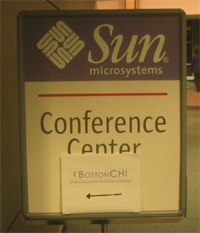 Stupid mistake #1: At Sun, the host for boston-chi, I realize I left my power cable back at Northeastern. Yes, I made the same mistake on tour #1. And yes, I am a moron. A quick call to Peter and there’s a shot it might still be in the room (it’s recovered later thx to him).
Stupid mistake #1: At Sun, the host for boston-chi, I realize I left my power cable back at Northeastern. Yes, I made the same mistake on tour #1. And yes, I am a moron. A quick call to Peter and there’s a shot it might still be in the room (it’s recovered later thx to him).
Nicole Yankelovich graciously donates her Powerbook, who’s screensaver provided entertainment at various intervals during the talk (I made up stories about the photos every time they came on: improv training comes in handy).
The crowd of about 50 people was great: they asked good questions, played along with my jokes and we had a fun time. I spoke about What to do when things wrong (slides / audio), a topic from the book.
Relying on kindness again, I snagged a ride from the rising design star Sam Aquillano from IDSA Boston. I see great things in his future. Plus he has an ungodly gift for finding his way through dark and confusing parts of Boston.
Back at the hotel at 9:30pm, I snagged another cab (#3 for the trip so far), met Peter at Northeastern, and then doubled back to the hotel, power cable intact. Back at the hotel at 10:30pm, I realize lunch at O’reilly was the only meal I’d had all day. I stay up late preping for Wednesday’s lectures at MIT and chowing down on the most expensive Turkey sandwhich in history via room service. 2 lectures down, 7 to go.
I instructed the cab to make two stops: one back at the hotel to drop off most of the books, the other at Northeastern, near the core of Boston. At the hotel I run up inside, look longingly at the comfy bed I’d left so early, and run back down to the cab. We speed away to Huntington avenue, which splits the Northeastern campus roughly in half. The problem is street numbers: somehow less than half of the buildings feel obligated to help us figure out where the hell we are, so we move slowly up the street, cranning our necks, calling out numbers. Finally we see a tower of a building ahead on the left, and I know it’s it. We turn around and I run inside.
Peter Tarasewich, my kind host at the Computer & Information Sciences department, showed me around their cool offices and then takes me to another building for the lecture.
 At 3:30pm I talk to 70 or 80 students and faculty about software design in a talk called “Why software sucks: and what to do about it” (essay here). 30 seconds into the talk I’m interupted by an imporant, but distruptive question. A few minutes later there’s another question from the same man, and then another. It turns out this was the highly esteemed Matthias Felleisen and this approach to lectures is simply his way (The questions were good, but the timing and tone was less than friendly). The rest of the crowd had more patience for me and we had some good discussions about the meaning of “code is poetry” and what it means to make good things. The post talk e-mail was good: lots of follow up questions which is always fun.
At 3:30pm I talk to 70 or 80 students and faculty about software design in a talk called “Why software sucks: and what to do about it” (essay here). 30 seconds into the talk I’m interupted by an imporant, but distruptive question. A few minutes later there’s another question from the same man, and then another. It turns out this was the highly esteemed Matthias Felleisen and this approach to lectures is simply his way (The questions were good, but the timing and tone was less than friendly). The rest of the crowd had more patience for me and we had some good discussions about the meaning of “code is poetry” and what it means to make good things. The post talk e-mail was good: lots of follow up questions which is always fun.
At 4:30pm I called Matt, the chair of the bostonchi.org chapter for a ride to next gig: speaking at BostonCHI.
Over the next week I’ll be posting about the tour. If this bores the pants off of you just watch for the BT flag and skip.
Tuesday 10/12: First thing Tuesday morning (ok – first thing after I woke up) i made my way via cab to the O’Reilly office in Cambridge. I’d been warned the place was to hard to find: they were right. I didn’t trust the cab driver as he zig-zagged me through tiny suburban streets, the meter running higher as my confidence declined. There’s always a moment in cab rides when I think “Wait. I have no idea where I am and he could be taking me anywhere”. After a few false positives (him “is this it?” me “How would I know?”) we arrived at a simple but mostly unmarked two story office complex. I wandered inside (asking the reluctant cabbie to wait) and soon found a wall of O’Reilly books: I’d arrived at the world of tomes with animal covers.
I soon met Marlowe Shaefer, the fantastic production editor for The art of project management. Production editors are the PMs for the making of books and Marlowe simply kicked ass. There’s something wonderfully bizzare about meeting someone for the first time, despite working with them intensely over the phone for months. After a nice, but quick, lunch with Mike (the main editor for artofpm) and Mary, two O’reilly editors, I grabbed the box of promotional books they’d provided for me and headed to Northeastern University for Talk #1 of 9. I gave the cab driver the address, which he shrugged at, despite pulling away from the curb, and I hoped for the best.
This week in the pm-clinic discussion forum: Topic #49 -Death by autonomy.
Here’s this week’s situation:
I’m an engineer at a well known search company (rhymes with frugal). My loosely structured team is big on indepenendence but is starting to be low on maintenance: there’s some work that needs to be done to support the work 4 or 5 of us are doing, but that no one really loves or wants to do. So often it doesn’t get done.
How to you make sure maintenance and grunt tasks actually get done (especially if you’re working in a highly independent environment (intentionally weak hierarchy))?
– Signed D.B.A.
On tour, day 1: Columbus day (10/10). There’s something pathetic about waiting 5 extra hours in your own airport. Somehow waiting in distant airports is more dignified: at least you’ve moved. But given that the entire radar system in boston was down, travel was a bad idea all around: I didn’t protest. I briefly considered flying into NYC and driving up, but the math didn’t work out. I had faith (perhaps blind) in the unkown Boston radar mechanics which worked out. I arrived at the swanky Hotel marlowe near midnight (a splurge to compensate for nights on friends couches), and prayed to the book tour gods for better luck on the rest of my 10 day, 9 lecture trip.
Next: Lecturing at Northeastern and Boston-CHI